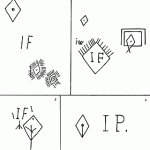
Salzkammergut rhombi
In the research area of Upper Austrian Salzkammergut rhombi can be found at 32 of 44 sites (73 %). Thus it is the sign with the widest distribution. The rhomb occurs in all altitudes and in all sorts of sites. The places with the greatest number of rhombi are: Kienbachklamm, Echerntal and Steinberg, Nieder Dürren and Sulzbach.
by Werner Pichler
The rhombus: reflections about a very frequent rock art sign
Preface
In the last centuries some ten thousand examples of rock art have been found in the Alps. In comparison to a lot of well described places in the Western Alps there existed nearly no comprehensive documentation about the Eastern Alps since the nineties.
In 1992 a project named “research and documentation of the rock art of Upper-Austrian Salzkammergut” was started, sponsored by FWF (Fonds zur Förderung der wissenschaftlichen Forschung). The project dealt with an area of about 1000 km² in the southern part of Upper Austria, reaching from the north-western slope of Dachstein, the central Salzkammergut around Bad Ischl to the Wolfgangtal with its famous Kienbachklamm. The main goal was a well aimed search including the knowledge of several native researchers. The results of the research were published in four parts according to the regions Kienbachklamm, Wolfgangtal, Northern Dachstein mountains and Central and Northern Salzkammergut (Pichler 1994, 1997, 2000, in press): in total 227 rock art panels at 44 sites.
Having finished this project in 1999, it is now possible for the first time to undertake statistical analysis of single signs, sign groups, their frequency as well as their regional distribution and context.
Frequency and distribution
Among the great variety of signs only four of them occur more than a hundred times: simple crosses, cup marks, rhombi and ladders. With 13 % representations of rhombi range at the third place of frequency. I do not know any other rock art region with such a high frequency.
In the research area of Upper Austrian Salzkammergut rhombi can be found at 32 of 44 sites (73 %). Thus it is the sign with the widest distribution. Other frequent signs like ladders or “Radkreuze” are present only at 20 % respectively 25 % of the sites. The rhomb occurs in all altitudes (from 500 m to 1600 m) and in all sorts of sites (rock walls, rock slips, cave entrances). The places with the greatest number of rhombi are: Kienbachklamm (27), Echerntal and Steinberg (both 16), Nieder Dürren and Sulzbach (both 11).
Typology
Nowadays there are documented about 80 types of rhombi in the rock art regions of the Eastern Alps (from Bavaria to Styria). The 154 rhombi of Salzkammergut are distributed among 44 of these types. The distribution is not at all proportional: nearly 50 % of the representations fall to two types only to the rhomb without any competition and to the rhomb with a central cup mark. These two may well be the original forms of the sign, all of the others may be considered as variations. In a similar manner the cornered form seems to be the normal one (86 %) in comparison to the seldom curved variations. Only 3 % of the signs are drawn with a double outline (cornered as well as curved).
If you try to put the great variety in order it soon becomes clear that these signs cannot be the result of mere accident: each develops from another with only very small steps of alteration. All signs with high frequency are very similar to the central form. Only the very marginal types show greater differences.
Context
There are several examples of rhombi being the only engraving of a rock art panel: three examples on rock walls (Vormauerstein, Brustwand, Rossmoos), three at cave entrances (Hallerloch, Gartenloch, Jochwand-Halbhöhle). For most of the 154 rhombi there cannot be seen a clear connection to adjoining signs.
In one case each a rhomb may be related to a composition of either concentric circles, a ladder or a house. Two rhombi are connected with a penis engraved in a quite realistic manner, three with crosses. In six cases there is a significant proximity of rhombi with the letters IP (abbreviation for “requiescat in pace”) or IF (for the German version “Ruhe in Frieden”). These facts are most valuable when attempting an interpretation (Fig. 1, 2).
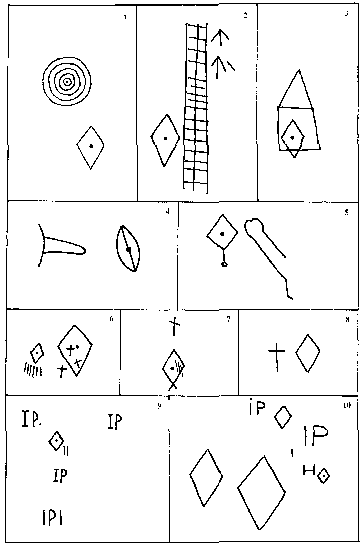
Fig. 1 Examples for the context of rhombi in the Salzkammergut, 1: Knappenwand, 2: Kienbachklamm, 3,4: Echerntal, 5: Seekarleiten, 6: Raucherkar, 7,8: Sulzbach, 9: Echerntal, , 10: Tropfwand,
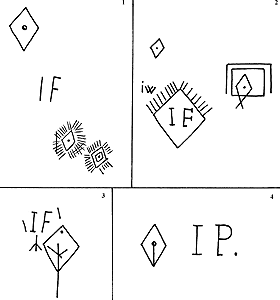
Fig.2: Examples for the context of rhombi in the Salzkammergut: 1,2: Nieder Dürren, 3: Kienbachklamm, 4: Jochwand
Interpretation
To clarify: I do not agree with the relativistic position declaring that the interpretation of rock art signs is impossible “per se”. This may be true for signs of Palaeolithic art. The greater the temporal (or spatial) distance of the interpreter to the object of interpretation, the more complicated is the access to possible meanings of signs.
But the presuppositions are totally different if the chain of tradition reaches till to historic periods. In such cases there often can be found enough indication for a thesis, so that interpretation obtains a very high degree of probability.
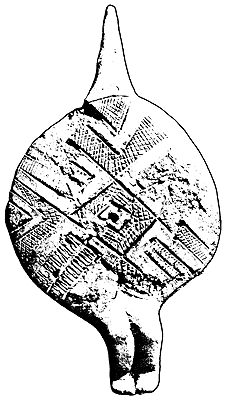
Fig. 3 Figurine from Malta
In the case of the rhomb we are in the fortunate position to know that the double rhomb was the sign for female sex in the Sumeric script. This intimate nexus between the rhomb and the female is shown extremely evident in a figurine from Malta: the high degree of abstraction of the exterior shape corresponds totally with the degree of abstraction of the inner expression of the female (Fig. 3). Müller-Karpe (1968: T176/294) shows some very illustrative examples of this idea among Neolithic figurines from Eastern Europe (Fig. 4).
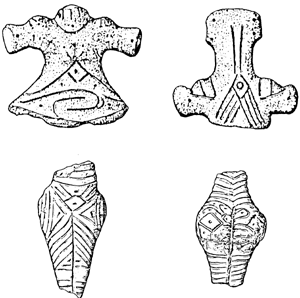
Fig. 4 Neolithic figurines from Eastern Europe
So there cannot be any doubt that the rhomb at the semiotic level of “signs” represents “pars pro toto” the female body and the idea of the female (equal to the sign triangle in other cultural regions of other periods).
Let us turn to the question of whether the rhomb can have a symbolic meaning too. There are a lot of indications, that quite early in the history of mankind the rhomb was connected with the idea of fertility, of live-giving power. Duerr (1984) documented, that for North American Indian tribes the central cup mark of rhombi had the meaning of a magic fertilisation. This symbols were associated with the woman as well as with female animals, the guarantee of survival for the early hunting societies (see the famous Magdalene hole-stick from Lorthet Fig. 5).
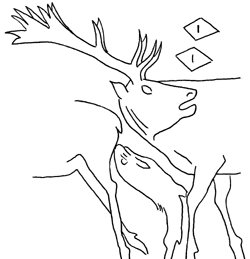
Fig. 5 Engravings on the hole-stick of Lorthet
The next step corresponding with the Neolithic revolution of settling down and developing agriculture was the idea of understanding the whole earth as female: to recognise the relationship between the fertility of soil and the female sexuality. For early agricultural society the female body of the earth was the place of regeneration of life. The entrance into the body of earth was possible through caves, so they were compared with the vagina of women. Therefore it can be no surprise that rhombi so often appear at the entrances of caves in Salzkammergut: at the Kalmosskirche, the Felszeichennische, the Jochwand-Halbhöhle as well as at the Gartenloch or the Seekarkirche. According to Neumann the symbolic meaning of natural caves changed over during the history of development to the cultural equivalents like temples, huts or houses. In all these cases doors and gates symbolise the womb of the motherly “vessel” (1987:57). Not infrequently the deep ritual importance of these thresholds between “inside” and outside” was manifested by strong symbols like the rhomb: by dozens of rhombi in lintels or great stones blocking entry to megalithic tombs or passage graves (Fourknocks, Newgrange). Does the idea that a lot of church doors in the Alps are decorated with rhombi stem from this tradition?
In fact there are several examples of the combination of houses and rhombi in the rock art of the Eastern Alps (e.g. Echerntal near Hallstatt) as well as in the folkloristic drawings like the ones in the steeple of St. Wolfgang (Fig. 6).
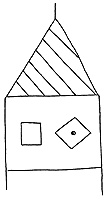
Fig. 6 Carving in the steeple of St. Wolfgang/Upper Austria
Some authors even have speculated upon the question, if some of the rhombi are situated exactly on that place, where the rising sun first touches the rock surface of cave entrances (Hasenhüttl 1979 for the Mausböndlloch). Since now there exists no detailed analysis about this presumption.
But it seems evident that there was a very close nexus between the symbolic meaning of the rhomb and the complexity of thoughts around the terms “life” and “death” for the creators of Alpine rock art. You can find striking evidence not only for the connection of rhombi and crosses but even more for rhombi and IP/IF.
Summary
Systematic analysis of the rock art in the Upper Austrian Salzkammergut produced strong evidence for the following thesis about the rhomb as a sign and symbol:
It is not correct to interpret these rhombi as incidental graffiti of bored hunters or herdsmen, they are part of very old traditions, transmitted from generation to generation and thereby modified in manifold ways. The rhomb represents not only the female body but the idea of fertility and regeneration. Despite the vehement attempts of the Catholic Church such pre-Christian belief survived in remote Alpine areas. The very old practice of marking cave entrances as wombs of the earth, later changed to artificial “temples”, and finally to profane buildings. Probably the life-giving power of the sun can be associated with this group of sign too. Only during the process of industrialisation and urbanisation of the last hundred years the understanding of the symbolic meaning was lost and the rhomb changed to an element of decoration.
Werner Pichler
INSTITUTUM CANARIUM
Wagrainerstr. 9
A-4840 Vöcklabruck
(This is a short version of a German paper published in ALMOGAREN XXX/1999, Institutum Canarium)
References
- Duerr, H.P. (1984): Sedna oder die Liebe zum Leben. Frankfurt/M.
- Hasenhüttl, G. (1980): Beitrag zur Sinndeutung einzelner Felszeichnungen. JB. der GEFEBI, Graz, 82
- Müller-Karpe, H. (1968): Handbuch der Vorgeschichte. Band II, Jungsteinzeit. Tafeln. München
- Neumann, E. (1980): Herrschafts- und Sexualsymbolik. Stuttgart
- Pichler, W. (1994): Die Felsbilder der Kienbachklamm. Studien zur Kulturgeschichte von Oberösterreich, Folge 2, Linz
- Pichler, W. (1997): Die Felsbilder des Wolfgangtales. Jahrbuch des OÖ. Musealvereines, Bd 141/I, Linz, 7-116
- Pichler, W. (1999): Die Raute ein Beitrag zur Problematik der Interpretation von Felsbildern.- ALMOGAREN XXX, Vöcklabruck, 35-64
- Pichler, W. (2000): Die Felsbilder des Nördlichen Dachsteingebirges. Jahrbuch des OÖ. Musealvereines
- Pichler, W. (2000): Die Felsbildstationen Kollergraben und Hochkogel am Südhang des Schafberges. Jahrbuch des OÖ: Musealvereins
- Pichler, W. (in press): Die Felsbilder des zentralen und nördlichen Salzkammerguts. Jahrbuch des OÖ. Musealvereins.








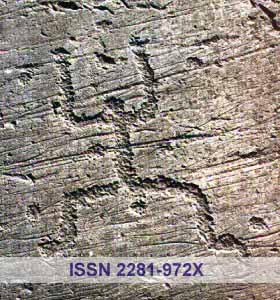













Leave a Reply